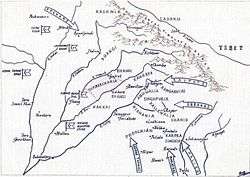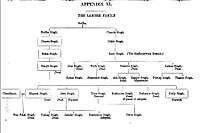Sukerchakia Misl

|
Sikh Confederacy (1707-1799) |
|
Phulkian Misl ·
Ahluwalia Misl ·
Bhangi Misl ·
Kanheya Misl ·
Ramgarhia Misl ·
Singhpuria Misl ·
Panjgarhia Misl ·
Nishanwalia Misl ·
Sukerchakia Misl ·
Dallewalia Misl ·
Nakai Misl ·
Shaheedan Misl
|
The Sukerchakia Misl was one of 12 Sikh Misls in Punjab during the 18th century concentrated in Gujranwala and Hafizabad district in Western Punjab (in modern-Pakistan) and ruled from (1752-1801). The Sukerchakia last Misldar (commander of the Misl) was Maharaja Ranjit Singh. Towards the end of the eighteenth century, Maharaja Ranjit Singh united all the misls and established an independent kingdom in Punjab.
History

Sardar Naudh Singh on becoming Khalsa was given a petty tract of land around Gujranwala that he renamed as Shukar Chak i.e. Thanks for the land. Sardar Charat Singh was the eldest son of Sardar Naudh Singh, the father of Maha Singh, and the grandfather of Ranjit Singh. Charat Singh created the Shukarchakia band or Misl.This misl was Sandhanwalia Jat misl.[1][2] He distinguished himself at an early age in campaigns against Ahmad Shah Abdali and split from the Singhpuria Misl to establish The Sukerchakia Misl in Gujranwala [3][4][5]. He married Sardarni Desan Kaur the daughter of Sardar Amir Singh of Gujranwala, an older but still powerful sardar, and moved his headquarters there. He extended his rule in Rohtas, Chakwal, Pind Dadan Khan which Stood in Pothohar Region of Northern Punjab and took Wazirabad under his control. Then came Sardar Maha Singh (d.1792) who also expanded the Misl further. After the decline of the Mughals, Maharaja Ranjit Singh united all the misls and shaped a powerful kingdom in Punjab.
Battles fought by Sukerchakia Misl
- Battle of Lahore, (1759)
- Battle of Sialkot (1761)
- Battle of Gujranwala (1761).[6][7]
- Sikh Occupation of Lahore.[8]
- Battle of Sialkot (1763).[6]
- Battle of Amritsar (1797)
- Battle of Gujrat (1797)
- Battle of Amritsar (1798)
References
- ↑ Khushwant Singh (2008). "Chapter 1: Ranjit Singh's Ancestors, Birth and the Years of Tutelage". Ranjit Singh, Maharaja of the Punjab. Penguin Books, India. pp. 1–3. ISBN 9780143065432.
- ↑ http://www.sikh-history.com/sikhhist/warriors/charat.html
- ↑ Lafont, Jean-Marie (2002) Maharaja Ranjit Singh, Lord of the Five Rivers. Oxford: Oxford University Press
- ↑ See:
- "Two, Ranjit Singh who seemingly got "total ascendancy" in Punjab was not a Jat but a Sansi...", Sangat Singh, McLeod and Fenech as Scholars on Sikhism and Martyrdom; presented in International Sikh conferences 2000, www.globalsikhstudies.net
- Singh, Sher (1965) The Sansis of Punjab: a Gypsy and denotified tribe of Rajput origin; Maharaja Ranjit Singh: the most glorious Sansi, p. 13. Delhi: Munshiram Manoharlal
- Singh, Sangat (1995) The Sikhs in History; 2nd ed. New York: S. Singh ISBN 0-9647555-0-5; p. 92
- Singh, Fauja (1981) Some Aspects of State and Society Under Ranjit Singh. New Delhi: Master Publishers; p. 5
- Sandhawalia, Preminder Singh (1999) Noblemen and Kinsmen: history of a Sikh family. New Delhi: Munshiram Manoharlal ISBN 81-215-0914-9
- ↑ This claim arose when "a Sansi Jat t clan was also recorded in early imperial censuses, which were rather crude and inaccurate. But the numbers of this "Jatt" clan were extremely small , indicating it, at best, as a very recent accretion into... a functional category , composed of diverse farming identities". See "Family Tree of Maharaja Ranjit Singh, the Great Sansi". www.sikhcastes.com. 11 August 2012. Retrieved 19 November 2015.
- 1 2 Jacques, Tony. Dictionary of Battles and Sieges. Greenwood Press. p. 419. ISBN 978-0-313-33536-5. Archived from the original on 2015-06-26.
- ↑ Raj Pal Singh (2004). The Sikhs : Their Journey Of Five Hundred Years. Pentagon Press. p. 116. ISBN 9788186505465.
- ↑ Grewal, J.S. (1990). The Sikhs of the Punjab. Cambridge University Press. p. 91. ISBN 0 521 63764 3. Retrieved 15 April 2014.
External links